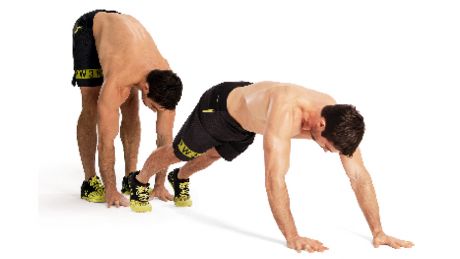The Hand Walk-out: The Brutal Shortcut To A Stronger Core
Challenge your core at home with this fiendishly tough bodyweight move

While it’s true to say you can exercise any part of the body effectively without equipment, it’s especially true to say that of the core. The best core exercises like the plank or bicycle crunch require no equipment at all, and they can be done anywhere you have the space to lie down.
The hand walk-out is a great example of this. It’s one of the best bodyweight exercises for your core, and it also targets your shoulders and upper torso while stretching your legs, glutes and lower back. All of the above make it a great addition to any workout or even your warm-up, since it activates so many muscles in the body.
How To Do The Hand Walkout
From a standing position, fold at your hips and put your hands on the ground in front of your toes. Gradually walk your hands forwards past the press-up position and as far as you can stretch. Then slowly walk them back into the starting position. The walk out and back counts as one rep: try to get through three sets of five.
For an easier version of the walk-out, you can rest on your knees and move your hands forwards and back from that position.Once it’s comfortable, you can try the full walk-out.
If you decide that even the walk-out isn’t enough to truly rock your body, then you can throw a press-up into the mix (as you can with almost every situation to make it a little more fun). As you reach the press-up position, with your hands directly underneath your shoulders, drop down and push up before continuing on your merry way.
When you include the hand walk-out in a warm-up, don’t let your hands walk further than your shoulders.
Hand Walkout Vs Abs Rollout
The hand walk-out is an equipment-free version of the abs roll-out, where you roll your hands forwards on a barbell or using a dedicated abs roller designed for the move. Both are great core exercises, but the walk-out is slightly more convenient since you don’t need equipment, and it’s also a little safer because it’s easier to control how far you stretch forwards. However, it’s still possible to overstretch yourself and hurt your lower back or shoulders. Don’t go too far.
Get the Coach Newsletter
Sign up for workout ideas, training advice, reviews of the latest gear and more.

Nick Harris-Fry is a journalist who has been covering health and fitness since 2015. Nick is an avid runner, covering 70-110km a week, which gives him ample opportunity to test a wide range of running shoes and running gear. He is also the chief tester for fitness trackers and running watches, treadmills and exercise bikes, and workout headphones.









